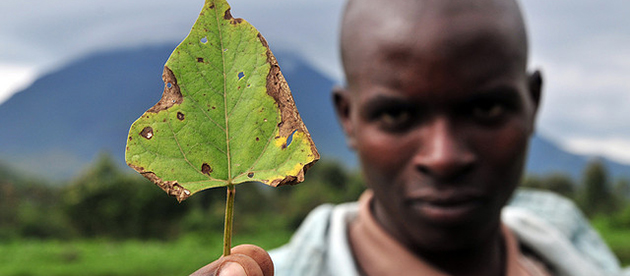Despite major successes in the continuous battle against the pests and diseases that blight agricultural production, millions of farmers across the world still lose part or their entire crop every year, affecting food security and livelihoods.
Take cassava for example. Scientists in Asia are battling witches broom, which is devastating yields in the region. And in Africa the race is on to impede the spread of cassava brown streak disease.
For the common bean, often referred to as the ‘meat of the poor’, CIAT and PABRA scientists have spent many hours in the lab and in the field developing new varieties that are resistant to a whole host of pests and diseases – such as common bean blight, angular leaf spot and bean rust.
But, the threat remains. Viruses evolve, bacteria develop new strains and pests become immune. It’s an on-going fight.
One trick, which will be adopted by a new McKnight Foundation funded CIAT-led project in Kenya, is anticipation and preparation.
Western Kenya is one of the main food baskets in the country and home to around one third of the population. Legumes, including beans, are an important crop but productivity has declined and yields are low (typically less than 1 ton per hectare, 30% less than the genetic potential).
Huge government and donor investments are pouring into the area to improve and disseminate legume technologies, and thus lift yields out of the doldrums. The three year project will offer protection for these investments by assessing and anticipating potential threats and putting in place mechanisms to help farmers and extension workers identify and manage them effectively, and thus improve resilience to epidemics.
The project will build on previous McKnight-funded research, which resulted in a complete georeferenced dataset of the socio-economic profiles of the legume farming community, and pest and disease characteristics for the long and short growing seasons in the six agro-ecologies of Western Kenya.
The study found that most of the legumes in the area are affected by foliar and root rot pests and diseases, many of which are seed-borne. As a result, the new project will also focus on the role of seeds in the transmission of diseases, working with farmers and seed providers to find solutions.
The new project – “Supporting investments in upscaling of grain legumes in western Kenya through assessing and modelling the threat of biotic stressors” – is a collaboration between CIAT and Kenyan partners including Masinde Muliro University of Science and Technology (MMUST), University of Nairobi (UoN), Kenya Agricultural Research Institute (KARI) and Appropriate

